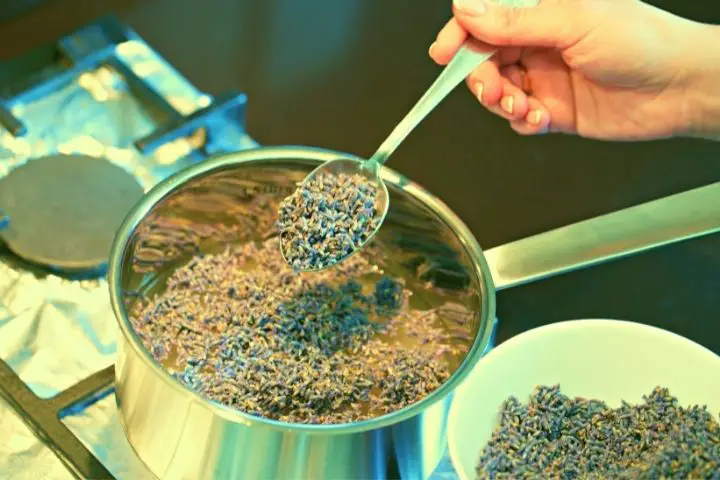Can You Eat Lavender Essential Oil – The Dos and Don’ts of Lavender
The short answer is no! Essential oils are not to be ingested, however, lavender can be consumed in many other ways!
Lavender essential oil has so many benefits, it’s hard to keep track! From relieving anxiety to using this essential oil as a deodorant, lavender essential oil should be a staple in every household.
But while its scent may tempt you to have a taste, lavender essential oil should never be ingested.
That being said, there are many other forms of lavender that are safe for ingestion and many ways in which you can use them.
Can you ingest essential oils?
Essential oils are great for your skin, hygiene, your bedroom and your mood – not so much for your insides. Quite the opposite of their relaxing aromas, essential oils can burn the inner linings of the mouth, gut and other organs, disrupting your digestive processes. You are likely to experience nausea and other discomfort, and excessive ingestion can be extremely dangerous. So keep the essential oils for sniffing, not snacking!
Can you eat lavender?
Even though you can’t consume lavender essential oil, that doesn’t mean that other lavender products are out of the question. Lavender in other forms can actually be very beneficial for your health, including improving digestion, sleep and mood.
Lavender for cooking

Lavender is an unsung hero that can be used in so many dishes, either as a main ingredient or garnish. If you are using lavender in your cooking, you may prefer to use lavender specifically sourced for cooking (referred to as culinary lavender), as aromatic lavender might be too overpowering in your food.
You can find it in many grocery stores, both fresh and dried, and can use either depending on what dish you have in mind. Dried lavender is much more potent than fresh, so you’ll want to be careful not to add too much. That being said, if you really enjoy the taste of lavender, feel free to use as much as you like!
A few ways to use culinary lavender include:
- In your marinade for meats or sauces
- In baked goods such as cookies and cakes
- As a garnish to bring the visuals of your dish together
Lavender syrup
This is certainly a fan favorite. A sweet syrup with a hint of lavender? Yes please! And the best part is that you can make this easily in your kitchen. All you need is water, sugar and lavender petals. Let it simmer, then cool down – and now you have your own homemade lavender sweetener. This can be used in all types of drinks – tea, coffee, lemonade, cocktails – and is an especially great addition to baking if you want to add a unique touch to your pastries. But use quickly, as lavender syrup stored in the fridge only lasts about two weeks. Lavender overload here we come!
Lavender oil
No, not the essential oil. Lavender oil is a safe option not only for all the same uses as essential oils, but also for consumption. It can also be consumed in the form of lavender capsules, which are commonly used to alleviate anxiety.
Lavender ice-cream
This is a personal favorite of mine and my kids! I still clearly remember as a young girl coming across this ‘purple’ ice cream and feeling so intrigued. I was amazed to learn that there was such a thing as lavender ice cream! The taste is great – sweet like any ice cream with a floral hint! I love it.
Lavender Earl Grey Tea
I am a keen loose leaf tea drinker and one of my favorite tea flavors is a comforting earl grey with a hint of lavender. There are many tea brands out there that offer lavender earl grey. If you are a tea drinker, I highly recommend trying it.
Frequently Asked Questions

Can you be allergic to lavender?
You can most definitely be allergic to lavender. In fact, it is always strongly recommended to use lavender essential oils in moderation, as too much can cause irritation, especially for children. If you haven’t used lavender before, it’s best to do a test run to make sure your body doesn’t have any negative reactions.
Can you eat lavender directly from the plant?
Lavender leaves and petals can be used directly in your meals! Either as a garnish or as a main ingredient in a salad, it is completely safe to pluck parts of the lavender plant as you would other herbs and add it to your food.
Can I make dried lavender at home?
Making dried lavender may sound daunting, but it’s actually quite straightforward. All you need is some fresh lavender and a dark, warm room. Gather some lavender stems into bunches (imagine you’re making tiny bouquets) and tie them together. The key is to hang the lavender upside down – this helps retain their shape while they’re drying out. Additionally, you want to keep them away from heat and humidity so you don’t interrupt the drying process. In about a week or so, you should have fragrant dried lavender ready for your intended use.
An alternative option for quicker drying is using your trusty oven. Lay the lavender out in a pan, making sure they don’t overlap, and leave them in the oven at a low temperature for a few hours, flipping periodically. Within a day, you should have some nicely dried herbs.






